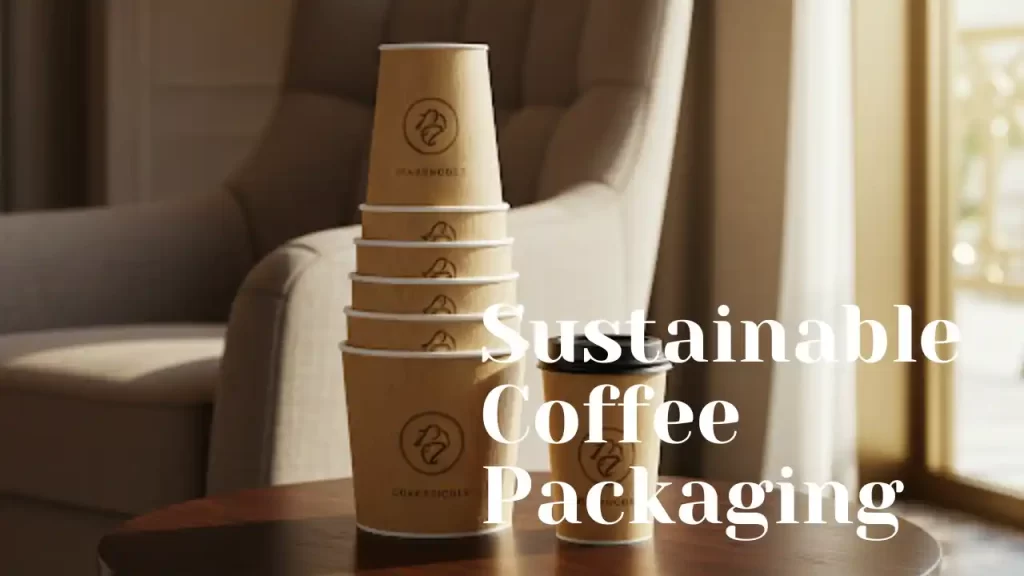In today’s coffee industry, balancing cost and sustainability in coffee packaging is a pressing challenge. As eco-conscious consumers increasingly demand environmentally friendly packaging, coffee brands must find ways to meet these expectations without compromising their budgets. In this guide, you’ll discover how to balance cost and sustainability in coffee packaging without compromising quality.
Whether you’re a small-batch roaster or a growing brand. Let’s explore practical, scalable approaches to packaging that’s as kind to your bottom line as it is to the environment.
Why Sustainable Coffee Packaging Matters
Sustainable coffee packaging is more than a trend—it’s a strategic imperative for brands aiming to thrive in a competitive and environmentally conscious market.

Here’s why it matters:
· Environmental Impact:
Coffee packaging significantly contributes to environmental waste, particularly when non-recyclable materials like plastic-lined paper cups are used.
The entire lifecycle of disposable cups starting from raw material extraction to production to transportation requires significant energy, contributing to environmental degradation. These materials often end up in landfills, releasing microplastics and other pollutants into the environment.
Adopting sustainable packaging options, such as recyclable or compostable materials, can mitigate these negative effects and reduce the overall carbon footprint of the coffee supply chain.
Did you know! “Packaging accounts for roughly 3% of the total carbon footprint of the coffee supply chain.”
You May Also Read: Top 10 Sustainable Hotel Innovations: Eco-Friendly Travel Trends
· Consumer Expectations:
Modern consumers are increasingly environmentally conscious and prefer brands that align with their values.
Studies indicate that nearly 54% of European coffee consumers prioritize packaging claims such as ‘less plastics’ and ‘recyclable’ when making purchasing decisions.
By adopting sustainable packaging, coffee brands can meet these consumer expectations and enhance their appeal in the market.
· Brand Image:
Sustainable packaging not only meets consumer demands but also enhances brand reputation and customer loyalty.
Research shows that 44% of consumers affirm that sustainable packaging positively influences their repurchasing decisions, and one in five would forgo purchasing a coffee brand perceived as unsustainable.
By demonstrating a commitment to environmental responsibility, brands can differentiate themselves and build stronger relationships with their customers
· Regulatory pressures
Governments worldwide are implementing regulations to reduce environmental waste, such as bans on single-use plastics and extended producer responsibility laws.
For instance, San Francisco has enacted comprehensive bans on various foam products, including polystyrene coffee cups, to mitigate environmental harm.
Staying ahead of these regulations by adopting sustainable packaging practices can help coffee brands avoid potential fines and align with legal requirements.
In summary, sustainable coffee packaging is crucial for environmental protection, meeting consumer expectations, enhancing brand image, and complying with regulatory standards.
By prioritizing sustainability, coffee brands can position themselves for long-term success in an increasingly eco-conscious market.
The Cost Challenge in Sustainable Packaging
Why sustainable materials can be more expensive.
While sustainable coffee packaging often entails higher upfront costs, it’s crucial to consider the broader financial picture. The initial investment in eco-friendly materials and processes can lead to significant long-term savings and benefits.
For instance, sustainable packaging can reduce waste management expenses, as biodegradable and reusable solutions generate less waste, leading to lower disposal and recycling costs over time
Hidden costs of not going green
Moreover, sustainable packaging can enhance brand reputation and foster customer loyalty.
As consumer awareness of eco-friendly practices grows, companies that adopt sustainable packaging can differentiate themselves in the market, appealing to environmentally conscious buyers and reinforcing their commitment to corporate social responsibility.
Additionally, aligning with sustainability regulations has become increasingly crucial as governments worldwide impose stricter restrictions on single-use plastics and promote greener alternatives through incentives.
By proactively adopting sustainable packaging solutions, businesses can ensure compliance, mitigate regulatory risks, and position themselves as leaders in responsible innovation.
In summary, while the transition to sustainable packaging may require an initial financial commitment, the long-term benefits far outweigh the upfront expenses.
By embracing eco-friendly alternatives, businesses can not only reduce their environmental footprint but also bolster their bottom line through cost savings and incentives.
You May Also Read: 5 Best Carbon Accounting Software to Reduce Your Carbon Footprint
How to Balance Cost and Sustainability in Coffee Packaging
Balancing cost and sustainability in coffee packaging requires a multifaceted approach.
By carefully selecting materials, optimizing design, leveraging purchasing strategies, exploring hybrid solutions, and focusing on long-term returns, coffee brands can achieve both economic efficiency and environmental responsibility.

A. Material Selection
Biodegradable vs. Compostable vs. Recyclable
Biodegradable: Breaks down naturally over time but may leave residues.
Compostable: Decomposes into non-toxic components under specific conditions, ideal for industrial composting facilities
Recyclable: Can be processed and reused in manufacturing, reducing the need for virgin materials.
You May Also Read: Visual Comparison of Biodegradable Vs. Non-Biodegradable Biomaterials
Cost Comparison of Materials
Kraft Paper: Approximately $0.80–$1.20 per kg; affordable and widely available.
PLA (Polylactic Acid): Around $2.50–$3.50 per kg; compostable but higher in cost.
Plant-Based Films: Costs vary; offer sustainability benefits but may require specialized processing.
B. Smart Design Choices
1. Lightweighting
Reducing material thickness and weight without compromising integrity can lower material costs and shipping expenses.
2. Minimalist Design
Simplifying graphics and using fewer colors can decrease printing costs and reduce environmental impact..
C. Bulk Purchasing & Supplier Negotiation
Bulk Buying
Purchasing materials in larger quantities often results in lower per-unit costs and reduces packaging waste.
Partnering with Ethical Suppliers
Collaborating with suppliers who prioritize sustainability can lead to better pricing and shared environmental goals..
D. Hybrid Solutions
Partially Recyclable or Reusable Packaging
Combining recyclable components with reusable elements can balance cost and sustainability.
Combining Cost-Effective Materials with Sustainable Elements
Using affordable materials like kraft paper with sustainable features such as compostable linings can optimize both cost and environmental impact..
E. Long-Term Savings & ROI
Reduced Waste Disposal Costs
Sustainable packaging often results in less waste, lowering disposal fees and environmental compliance costs.
Enhanced Brand Loyalty and Premium Pricing Potential
Consumers are increasingly willing to support brands with strong environmental commitments, allowing for potential premium pricing and increased customer retention.
By implementing these strategies, coffee brands can effectively balance cost considerations with sustainability goals, leading to long-term success and positive environmental impact.
Case Studies: Brands Doing It Right
1. Meira (Finland)
Meira, a Finnish coffee producer, introduced the Vallilan Paahtimo range, utilizing Amcor’s AmLite Bio-based packaging made from sugarcane-derived polyethylene. This innovation reduced their packaging’s carbon footprint by 45% while maintaining product quality. Additionally, Meira recycles coffee waste into biogas, achieving significant CO₂ emission reductions annually.
2. Rogers Family Coffee (USA)
Rogers Family Coffee developed the OneCup, a single-serve pod made from over 97% bio-based and compostable materials, including PLA and paper-based lids. This initiative not only addressed environmental concerns but also maintained product freshness and quality.
3. DOMA Coffee (USA)
DOMA Coffee collaborated with The BoxMaker to redesign their secondary packaging, replacing traditional corrugated cartons with custom auto-bottom tuck-top cartons. This change eliminated the need for packing tape, reduced material usage, and cut order pack-out time by 50%, leading to cost savings and improved sustainability.
4. Cambio Roasters (USA)
Cambio Roasters partnered with Zenpack to create a molded pulp container for their coffee pods, which doubles as a countertop recycling bin. This design encourages customers to recycle used pods, aligning with Cambio’s commitment to eco-friendly practices and reducing landfill waste.
5. Kua (Australia)
Kua, a social enterprise, implemented a circular model by delivering coffee beans in reusable canisters to workplaces and collecting used grounds for composting or repurposing into products like body scrubs. This approach not only minimizes waste but also supports community initiatives and environmental sustainability.
These examples illustrate how coffee brands can effectively integrate sustainable practices into their packaging strategies, achieving environmental goals without compromising on quality or incurring prohibitive costs.
Common Pitfalls to Avoid
⚠️ Greenwashing Risks
Greenwashing involves making misleading claims about the environmental benefits of a product or practice. In the coffee industry, this can manifest as vague terms like “eco-friendly” without substantiation or using nature-inspired imagery to imply sustainability. Such practices not only deceive consumers but can also lead to legal repercussions. For instance, Keurig faced a $3 million fine for falsely marketing their coffee pods as recyclable
How to Avoid Greenwashing:
- Be Specific and Transparent: Clearly define sustainability claims and provide evidence.
- Seek Third-Party Certifications: Utilize recognized certifications to validate environmental claims.
- Avoid Misleading Imagery: Ensure that packaging visuals accurately represent the product’s environmental impact.
🔍 Overlooking Supply Chain Transparency
A sustainable product requires a transparent supply chain. Without visibility into sourcing and production practices, it’s challenging to verify sustainability claims. Complex supply chains can obscure unethical practices, such as unfair labor conditions or environmental harm .
Strategies for Enhancing Transparency:
- Implement Traceability Technologies: Use tools like blockchain to track product origins.
- Engage in Open Data Initiatives: Participate in platforms that promote supply chain visibility .
- Collaborate with Certified Suppliers: Partner with suppliers who adhere to recognized sustainability standards.
You May Also Read: Is Aritzia Fast Fashion? A Comprehensive Analysis
⚙️ Sacrificing Functionality for Sustainability
While eco-friendly materials are essential, they must not compromise the packaging’s functionality. For example, using materials that don’t adequately protect coffee beans can lead to spoilage, negating environmental benefits.
You May Also Read: Going Green on the Go: 11 Smart Strategies for Decreasing Your Travel Carbon Footprint
Balancing Sustainability and Functionality:
- Conduct Material Testing: Ensure that sustainable materials meet performance requirements.
- Adopt Hybrid Solutions: Combine sustainable materials with functional design elements to maintain product integrity.
- Gather Consumer Feedback: Understand customer expectations to align sustainability efforts with usability.
By recognizing and addressing these pitfalls, coffee brands can develop packaging solutions that are both environmentally responsible and meet consumer expectations
Final Thoughts: How to Balance Cost and Sustainability in Coffee Packaging
In today’s competitive coffee market, balancing cost and sustainability in packaging isn’t just a noble endeavor—it’s a strategic imperative. By thoughtfully selecting materials, optimizing design, and fostering transparent supply chains, coffee brands can meet consumer expectations and regulatory demands while safeguarding their bottom line.
What are your thoughts on sustainable coffee packaging? Share your experiences or questions in the comments below.
Let’s continue the conversation and learn from each other’s journeys toward more sustainable practices.
FAQs
1. What is the most sustainable material for coffee packaging?
Compostable films, recyclable mono-materials, and biodegradable options are among the most sustainable materials for coffee packaging.
2. Does sustainable coffee packaging cost more?
Yes, sustainable packaging often has higher upfront costs, but it can lead to long-term savings through reduced waste disposal fees and enhanced brand reputation.
3. How does sustainable packaging affect coffee freshness?
Modern sustainable packaging materials are designed to preserve coffee freshness effectively, offering barrier properties that protect against moisture, oxygen, and light.
4. Is compostable packaging better than recyclable packaging for coffee?
Both have advantages; compostable packaging is beneficial where composting facilities exist, while recyclable packaging is suitable in areas with robust recycling programs.
5. Can sustainable packaging be customized for branding purposes?
Yes, sustainable packaging can be customized using eco-friendly inks, minimalist designs, and innovative materials to reflect your brand’s identity.
6. What are common challenges when switching to sustainable coffee packaging?
Challenges include higher initial costs, ensuring material compatibility with existing equipment, and navigating complex supply chains.
7. Are there regulations affecting coffee packaging sustainability?
Yes, various regulations aim to reduce environmental impact, such as bans on single-use plastics and requirements for recyclable or compostable materials.
8. How can I start transitioning to sustainable coffee packaging?
Begin by assessing your current packaging’s environmental impact, researching sustainable alternatives, and consulting with packaging experts.
9. How to Balance Cost and Sustainability in Coffee Packaging?
Use recyclable materials, simplify packaging design, purchase in bulk, and collaborate with ethical suppliers to reduce costs while maintaining sustainability.

